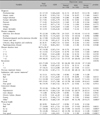1. Halioua B, Beumont MG, Lunel F. Quality of life in dermatology. Int J Dermatol. 2000; 39:801–806.

2. Devrimci-Ozguven H, Kundakci TN, Kumbasar H, Boyvat A. The depression, anxiety, life satisfaction and affective expression levels in psoriasis patients. J Eur Acad Dermatol Venereol. 2000; 14:267–271.

3. Jowett S, Ryan T. Skin disease and handicap: an analysis of the impact of skin conditions. Soc Sci Med. 1985; 20:425–429.

4. Ongenae K, Van Geel N, De Schepper S, Naeyaert JM. Effect of vitiligo on self-reported health-related quality of life. Br J Dermatol. 2005; 152:1165–1172.

5. Schmid-Ott G, Künsebeck HW, Jecht E, Shimshoni R, Lazaroff I, Schallmayer S, et al. Stigmatization experience, coping and sense of coherence in vitiligo patients. J Eur Acad Dermatol Venereol. 2007; 21:456–461.

6. Picardi A, Abeni D, Melchi CF, Puddu P, Pasquini P. Psychiatric morbidity in dermatological outpatients: an issue to be recognized. Br J Dermatol. 2000; 143:983–991.

7. Woodruff PW, Higgins EM, du Vivier AW, Wessely S. Psychiatric illness in patients referred to a dermatology-psychiatry clinic. Gen Hosp Psychiatry. 1997; 19:29–35.

8. Gupta MA, Gupta AK. Psychiatric and psychological co-morbidity in patients with dermatologic disorders: epidemiology and management. Am J Clin Dermatol. 2003; 4:833–842.

9. Blazer DG. Psychiatry and the oldest old. Am J Psychiatry. 2000; 157:1915–1924.

10. Watkins LL, Schneiderman N, Blumenthal JA, Sheps DS, Catellier D, Taylor CB, et al. Cognitive and somatic symptoms of depression are associated with medical comorbidity in patients after acute myocardial infarction. Am Heart J. 2003; 146:48–54.

11. Cole MG, Dendukuri N. Risk factors for depression among elderly community subjects: a systematic review and meta-analysis. Am J Psychiatry. 2003; 160:1147–1156.

12. Blazer DG. Depression in late life: review and commentary. J Gerontol A Biol Sci Med Sci. 2003; 58:249–265.

13. Robinson RG, Starkstein SE. Current research in affective disorders following stroke. J Neuropsychiatry Clin Neurosci. 1990; 2:1–14.

14. Aström M, Adolfsson R, Asplund K. Major depression in stroke patients. A 3-year longitudinal study. Stroke. 1993; 24:976–982.

15. Wragg RE, Jeste DV. Overview of depression and psychosis in Alzheimer's disease. Am J Psychiatry. 1989; 146:577–587.

16. Cummings JL. Depression and Parkinson's disease: a review. Am J Psychiatry. 1992; 149:443–454.

17. United Nation (UN). Report of the Second World Assembly on Ageing: Madrid, 8-12 April 2002. New York: UN;2002. p. 5–8.
18. Kowal P, Peachey K. Indicators for the minimum data set project on ageing: a critical review in sub-Saharan Africa. Dar es Salaam, United Republic of Tanzania: WHO;2001. p. 9.
19. Yesavage JA, Brink TL, Rose TL, Lum O, Huang V, Adey M, et al. Development and validation of a geriatric depressionscreening scale: a preliminary report. J Psychiatr Res. 1982-1983; 17:37–49.

20. Lee HJ, Kang SK, Lee JY. The effects of socioeconomic position and health behavior on geriatric depressive symptom. J Korean Gerontol Soc. 2008; 28:1129–1145.
21. Kent G, al-Abadie M. Factors affecting responses on Dermatology Life Quality Index items among vitiligo sufferers. Clin Exp Dermatol. 1996; 21:330–333.

22. Ongenae K, Van Geel N, De Schepper S, Naeyaert JM. Effect of vitiligo on self-reported health-related quality of life. Br J Dermatol. 2005; 152:1165–1172.

23. Hrehorów E, Salomon J, Matusiak L, Reich A, Szepietowski JC. Patients with psoriasis feel stigmatized. Acta Derm Venereol. 2012; 92:67–72.

24. Kurd SK, Troxel AB, Crits-Christoph P, Gelfand JM. The risk of depression, anxiety, and suicidality in patients with psoriasis: a population-based cohort study. Arch Dermatol. 2010; 146:891–895.
25. Esposito M, Saraceno R, Giunta A, Maccarone M, Chimenti S. An Italian study on psoriasis and depression. Dermatology. 2006; 212:123–127.

26. Koenig HG, Blazer DG. Epidemiology of geriatric affective disorders. Clin Geriatr Med. 1992; 8:235–251.

27. Abe Y, Fujise N, Fukunaga R, Nakagawa Y, Ikeda M. Comparisons of the prevalence of and risk factors for elderly depression between urban and rural populations in Japan. Int Psychogeriatr. 2012; 24:1235–1241.

28. Lee MS, Choi YK, Jung IK, Kwak DI. Epidemiological study of geriatric depression in a Korea urban area. J Korean Geriatr Psychiatry. 2000; 4:154–163.
29. Ongenae K, Dierckxsens L, Brochez L, van Geel N, Naeyaert JM. Quality of life and stigmatization profile in a cohort of vitiligo patients and effect of the use of camouflage. Dermatology. 2005; 210:279–285.

30. Shin BJ, Choe SW, Seo SJ, Hong CK. A clinical study of skin diseases in elderly patients. Korean J Dermatol. 2002; 40:1346–1352.
31. Liao YH, Chen KH, Tseng MP, Sun CC. Pattern of skin diseases in a geriatric patient group in Taiwan: a 7-year survey from the outpatient clinic of a university medical center. Dermatology. 2001; 203:308–313.

32. Mottram P, Wilson K, Strobl J. Antidepressants for depressed elderly. Cochrane Database Syst Rev. 2006; (1):CD003491.

33. Schneider LS, Olin JT. Efficacy of acute treatment for geriatric depression. Int Psychogeriatr. 1995; 7:Suppl. 7–25.








 PDF
PDF ePub
ePub Citation
Citation Print
Print




 XML Download
XML Download